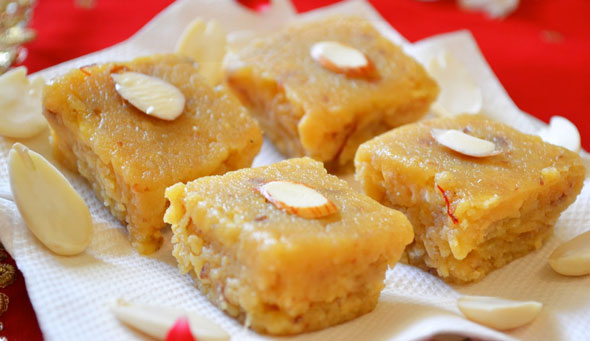Mama’s Punjabi Recipes: Badam di Burfi (Almond Milk Squares)
By popular demand from many readers, below is a reprint of Mama’s Badam di Burfi recipe.
Go to any Indian city and you will be sure to find a confectionary- or a halwai as they used to be called before they built fancy shops – where you will find many of the most popular and common sweets that Indians love. Among them, there will be a variety of burfi (milk squares), in one flavor or the other, all of which are particular favorites of young kids.
These days, you can even get burfi with a dark brown chocolate layer on top; and certainly those made with pista (pistachio), badam (almond) or kajju (cashew). They can be presented plain or with a traditional coating of warak (a very fine film of real silver or gold, though this is now only for special occasions) which astounds people – even second generation young Indians overseas – since they can’t believe one can eat a metal film!
The other item that is a universal favorite in India are badam (almonds) and these are eaten in many forms and especially as ingredients in making sweets. Almonds are native to the Middle East, North Africa and the Indian Subcontinent, but the majority of them are grown in California, which is the world’s top producer, while India is not even in the top 10 list.
In addition, badam are used in ceremonial havans (religious rites) since time immemorial and their oil is used for medicinal purposes as well as in cosmetics. Almonds are high in energy as they are high in carbohydrates, fat and protein as well as in many minerals, especially magnesium and phosphorus.
In the old-fashioned, traditional way, burfi is made by using whole milk, heavy with cream, and letting it boil on a stove till it has evaporated down to a thickened layer called khoya. It’s a time consuming process that requires patience, the ability to stand over a hot stove for long hours and continually stir the milk so that it doesn’t stick to the bottom and burn.
This recipe uses coarsely ground badam and is a fast way to make a tasty burfi that can match the store made ones. It is quick and easy to make – in about 30 minutes – and those who eat it will never know the difference!
Ingredients:
• 1 cup non-fat milk powder
• 1 cup badam powder (almond powder)
• 1/2 can condensed milk
Directions:
1. Pour the badam powder and milk powder in a bowl, then slowly add the sweet condensed milk and mix thoroughly.
2. Coat your hands with some vegetable oil so that the mixture will not stick. Then, knead the mixture with your hands and form into a ball.
3. Coat a large, clean dinner plate with a thin film of vegetable oil so that the mixture will not stick.
4. Take the ball out the bowl and place on the dinner plate.
5. Coat a velna (rolling pin) with some oil so that it won’t stick. Then use it to spread the ball on the plate into a ½ thick flat pancake.
6. Cover with some wax paper and place the plate in the fridge for 30 minutes.
7. Remove from fridge and then cut the pancake into 1.5 inch square or diamond shapes and serve at room temperature.
MAMA’S TIP OF THE WEEK: WHEN COOKING WITH A TAVA, DON’T WASTE THE LEFTOVER HEAT!
Many people still cook their rotis (flatbreads) fresh at home or at least heat them up on a tava (flatplate) or a frying pan. This is the best way to get the real flavor out of the wheat and roti, although many people will just cover the roti in paper and heat them in a microwave. I have noticed that there is a big difference between the two ways of heating roti: when done in the microwave, they come out slightly soggy but the tava makes them crispier.
But after the rotis are heated and the stove turned off, use the heat coming from the tava to warm up other items, like water or a bowl of dal or anything else. In this way, you are recycling the heat for other use!

Shakuntla Malhotra is a skilled cook of Punjabi dishes made in the old-fashioned style that she learnt as a young woman in her ancestral home in Lyallpur, India (since renamed Faisalabad) before it became part of Pakistan after the Partition in 1947. People have often admired her cooking for its simplicity and taste that comes with each mouthful. Even in her late-eighties, she continues to cook daily and agreed to share her delectable Punjabi vegetarian recipes for future generations.

